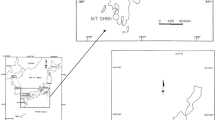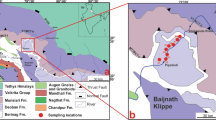Abstract
This study illustrates and discusses the physical properties, mechanical behavior, and microscopic characteristics of the South China Sea soft soil, and a comparison with the Bohai Sea marine clay, the Yellow Sea soft clay, and some typical marine soils is presented. In addition, the mechanisms of the difference in the geotechnical properties of these marine soils are revealed. Compared with the soils from other sea areas, the South China Sea soft soil presents remarkable characteristics of higher water content, larger void ratio, higher liquid limit, and higher content of fine particles. Besides, the South China Sea soft soil shows higher compressibility. As shown in the microscopic characteristics, the South China Sea soft soil contains lower content of clay minerals; in addition, due to the depositional and geological environments with higher salinity and higher temperature, there are more macropores, connected pores, and trellis pores in the South China Sea soft soil, so it presents a more open, flocculated structure rather than a granular-connection structure like the Bohai Sea marine clay and the Yellow Sea soft clay. The results presented in this paper will provide an important theoretical basis for revealing the engineering properties of marine soils, and improve the insights for ensuring the safety of ocean engineering during construction and service periods.










Similar content being viewed by others
Data availability
Data available on request from the authors.
References
ASTM International (2011) Designation: D2487-11 standard practice for classification of soils for engineering purposes (unified soil classification system). ASTM International, West Conshohocken
Bai B, Zhao CG (2003) Temperature effects on mechanical characteristics of clay soils. Rock Soil Mech 24(4):533–537 ((Chinese with English Abstract))
Ballas G, Garziglia S, Sultan N et al (2018) Influence of early diagenesis on geotechnical properties of clay sediments (Romania, Black Sea). Eng Geol 240:175–188
Bjerrum L (1954) Geotechnical properties of Norwegian marine clays. Géotechnique 4(2):49–69
Bjerrum L (1967) Engineering geology of Norwegian normally-consolidated marine clays as related to settlements of buildings. Géotechnique 17(2):83–118
Bo M, Choa V, Chu J et al (2017) Laboratory investigation on the compressibility of Singapore marine clays. Mar Georesour Geotec 35(6):847–856
Burland J (1990) On the compressibility and shear strength natural clays. Géotechnique 40:329–378
Cavallaro A, Grasso S, Maugeri M et al (2013) Site characterisation by in situ and laboratory tests of the sea bed in the Genova Harbour (Italy). Geotechnical and Geophysical Site Characterization 4(1): 637–644
Cecconi M, Scarapazzi M, Viggiani G (2010) On the geology and the geotechnical properties of pyroclastic flow deposits of the Colli Albani. Bull Eng Geol Environ 69(2):185–206
Chen J, Gilbert R, Ku A et al (2020) Calibration of model uncertainties for fixed steel offshore platforms based on observed performance in Gulf of Mexico Hurricanes. J Geotech Geoenviron Eng 146(6):04020039–04020042
Chen X, Zeng L, LÜ J et al (2008) Experimental study of mechanical behavior of structured clay. Rock Soil Mech 29(12):3223–3228 ((Chinese with English Abstract))
Chen X, Zhu H, Zhang F et al (2005) Experimental study on time-dependent deformation. Chin J Rock Mech Eng 12:2142–2148 ((Chinese with English Abstract))
Cui W, Liu D, Song H et al (2020) Experimental study of salt-resisting slurry for undersea shield tunnelling. Tunn Undergr Sp Tech 98:103322
Das Braja M (2021) Principles of geotechnical engineering. Cengage learning, Stamford
Du Y, Hayashi S, Shen S (2014) Impact of laver treatment practices on the geoenvironmental properties of sediments in the Ariake Sea. Mar Pollut Bull 81(1):41–48
El Howayek A, Bobet A, Santagata M (2017) Geologic origin effects on mineralogy, index properties and fabric of a fine-grained carbonatic deposit. Eng Geol 216:108–121
Graham J, Shields D (1985) Influence of geology and geological processes on the geotechnical properties of a plastic clay. Eng Geol 22(2):109–126
Guidobaldi G, Cambi C, Cecconi M et al (2018) Chemo-mineralogical evolution and microstructural modifications of a lime treated pyroclastic soil. Eng Geol 245:333–343
Indraratna B, Balasubramaniam A, Balachandran S (1992) Performance of test embankment constructed to failure on soft marine clay. J Geotech Eng 118(1):12–33
Jia R, Zheng G, Lei H et al (2020) The effects of the depositional environment and post-depositional processes on the engineering properties of Quaternary clays in the Saga Plain. Bull Eng Geol Environ 79:1137–1152
Jiang M, Li Z, Huang H et al (2017) Experimental study on microstructure and mechanical properties of seabed soft soil from South China Sea. Chin J Geotech Eng 39(S2):17–20 ((Chinese with English Abstract))
Jiao F, Du Z, Chen G et al (2021) Entrance zone length of extra-long undersea tunnels based on vision adaptation. Tunn Undergr Sp Tech 113:103970
Kong L, Lv H, Wang R et al (2002) Engineering properties and micro-mechanism of structural marine soil in Zhanjiang sea area. J Hydraul Eng 33(9):82–88 ((Chinese with English Abstract))
Lee C, Yun T, Lee J et al (2011) Geotechnical characterization of marine sediments in the Ulleung Basin. East Sea Eng Geol 117(1–2):151–158
Lee H, Chun S, Yoon S et al (1993) Slope stability and geotechnical properties of sediment of the southern margin of Ulleung Basin, East Sea (Sea of Japan). Mar Geol 110(1–2):31
Lei H, Wang L, Jia R et al (2020) Effects of chemical conditions on the engineering properties and microscopic characteristics of Tianjin dredged fill. Eng Geol 269:105548
Lei H, Wang L, Zhang W et al (2022) Impact of environmental acidity on the geomechanical and mineralogical behavior of marine clay. Bull Eng Geol Environ 81(35). https://doi.org/10.1007/s10064-021-02519-5
Lei H, Wang X, Chen L et al (2016) Compression characteristics of ultra-soft clays subjected to simulated staged preloading. KSCE J Civ Eng 20(2):718–728
Leroueil S, Vaughan P (1990) The general and congruent effects of structure in natural soils and weak rocks. Géotechnique 40:467–488
Liu C, Liao Y, Wang S et al (2020) Quantifying leakage and dispersion behaviors for sub-sea natural gas pipelines. Ocean Eng 216:108107
Liu S, Shao G, Du Y et al (2011) Depositional and geotechnical properties of marine clays in Lianyungang. China Eng Geol 121(1–2):66–74
Liu W, Yang Q, Kong G, et al (2022) Mechanical properties and elastoplastic constitutive model of undisturbed marine sediment. Chin J Geotech Eng 44(10):1837–1845 ((Chinese with English Abstract))
Low H, Phoon K (2008) Effect of cementation on the compressibility of Singapore upper marine clay. Can Geotech J 45(7):1018–1024
Low H, Phoon K, Tan T et al (2008) Effect of soil microstructure on the compressibility of natural Singapore marine clay. Can Geotech J 45(2):161–176
Luo H (1989) The composition microstructure and physico-chemical properties of marine soil in South China Sea. Rock Soil Mech 10(4):45–53 ((Chinese with English Abstract))
Morin R, Silva AJ (1984) The effects of high pressure and high temperature on some physical properties of ocean sediments. J Geophys Res 89(B1):511–526
Nian T, Fan N, Jiao H et al (2018) Full flow strength tests on the soft clay in the northern slope of the South China Sea. Chin J Geotech Eng 40(4):602–611 ((Chinese with English Abstract))
Nian T, Jiao H, Fan N et al (2019) Microstructure analysis on the dynamic behavior of marine clay in the South China Sea. Mar Georesour Geotec 37:1–14
Pan K, Yuan Z, Zhao C et al (2022) Undrained shear and stiffness degradation of intact marine clay under monotonic and cyclic loading. Eng Geol 297:106502
Paul M, Peacock J, Wood B (1992) The engineering geology of the Carse clay at the National Soft Clay Research Site, Bothkennar. Géotechnique 42(2):16
Silva A, Hollister C (1979) Geotechnical properties of ocean sediments recovered with the giant piston corer: Blake-Bahama Outer Ridge. Mar Geol 29(1–4):1–22
Silva A, Hollister C, Laine E et al (1976) Geotechnical properties of deep sea sediments: Bermuda Rise. Mar Georesour Geotec 1(3):195–232
Silva A, Laine E, Lipkin J et al (1984) Geotechnical properties of sediments from the north central pacific and northern Bermuda rise. Mar Georesour Geotec 5(3–4):235–256
Sridharan A, Prakash K (1999) Influence of clay mineralogy and pore-medium chemistry on clay sediment formation. Can Geotech J 36(S):961–966
Wang L, Lei H, Bo Y et al (2020) Geotechnical behavior of natural marine soft soils and deep sea soft clays. Conf Ser: Earth Environ Sci, China Rock 2020. Beijing, 570:062036
Wang Q, Wang J (2000) A Study on fractal of porosity in the soils. Chin J Geotech Eng 22(4):496–498 ((Chinese with English Abstract))
Wichtmann T, Andersen K, Sjursen M et al (2013) Cyclic tests on high quality undisturbed block samples of soft marine Norwegian clay. Can Geotech J 50(4):400–412
Wu C, Ye G, Zhang L et al (2015) Depositional environment and geotechnical properties of Shanghai clay: a comparison with Ariake and Bangkok clays. Bull Eng Geol Environ 74:717–732
Yang A, Yan S, Du D et al (2010) Experimental study of alkaline environment effects on the strength of cement soil of Tianjin marine soft soil. Rock Soil Mech 31(9):2930–2934 ((Chinese with English Abstract))
Yang A, Yang S, Zhang J, et al (2022) Study on thixotropic properties of Tianjin soft clay. J Eng Geol. (in press). (Chinese with English Abstract)
Ye G, Lin N, Bao X et al (2018) Effect of Quaternary transgression and regression on the engineering properties of Shanghai soft clays. Eng Geol 239:321–329
Yin L, Wang X, Zhang L (2010) Probabilistical distribution statistical analysis of Tianjin soft soil indices. Rock Soil Mech 31(S2):462–469 ((Chinese with English Abstract))
Zhang D, Liu S, Yu X (2003) Discussion on the engineering characteristics of marine soft soil and method for its treatment in Lianyungang. J Eng Geol 11(3):250–257 ((Chinese with English Abstract))
Funding
This study is supported by the National Natural Science Foundation of China (NSFC) (No. 52078334) and the National Natural Science Foundation of China (NSFC) (No. 51890911).
Author information
Authors and Affiliations
Corresponding author
Ethics declarations
Conflict of interest
We declare that we do not have any commercial or associative interest that represents a conflict of interest in connection with the work submitted.
Rights and permissions
Springer Nature or its licensor (e.g. a society or other partner) holds exclusive rights to this article under a publishing agreement with the author(s) or other rightsholder(s); author self-archiving of the accepted manuscript version of this article is solely governed by the terms of such publishing agreement and applicable law.
About this article
Cite this article
Lei, H., Wang, L., Zhang, W. et al. Geotechnical properties of the South China Sea soft soil: a comparative study with the soils from Bohai Sea and Yellow Sea. Bull Eng Geol Environ 82, 158 (2023). https://doi.org/10.1007/s10064-023-03178-4
Received:
Accepted:
Published:
DOI: https://doi.org/10.1007/s10064-023-03178-4




